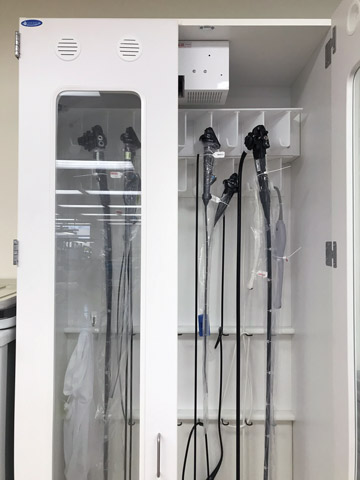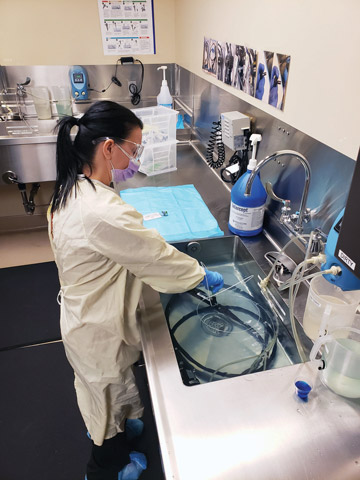Risks associated with biocide failure in the processing of flexible endoscopes are significant.
Endoscopy centers have become laser-focused on keeping procedure rooms fully scheduled to maximize the use of resources and patient throughput. This has a ripple effect throughout the chain of support services which enable supplies, capital equipment and instruments to be ready and available when the patient and physician are scheduled for an endoscopy procedure.
This is in no small part due to the rapid rise in endoscopy procedure volumes over the past several years.1 According to a study published by iData in 2019, there were 31 million GI endoscopy procedures performed in the United States alone in 2018,2 and there is every reason to expect continued procedure growth over the next two to three years.
This rise in endoscope use places strain on an already challenged processing environment. Pressure to increase volumes of scopes prepared for the next procedure invites compromises in manual cleaning and disinfection procedures, which has been well documented in recent peer-reviewed research.3
According to Cori Ofstead, MSPH, in the American Journal of Infection Control, "Reprocessing failures can have dire consequences for patients, and infections have been associated with ureteroscopes, cystoscopes, bronchoscopes, colonoscopes, gastroscopes, and duodenoscopes."4
To meet the increased procedure demand, endoscopy centers have responded with investment in tools and staff to manage the expanding workload. The automated endoscope reprocessor (AER) is playing a tireless role in ensuring endoscopes are available and properly disinfected as needed. Reprocessing flexible endoscopes in today's fast-paced clinical environment demands consistent, effective high-level disinfection (HLD) using AERs. Yet, despite advancements in technology over the last decade, AER operators are still required to manually test biocide minimum recommended concentration (MRC) levels during every cycle using a test strip.
If the biocide concentration level falls below the amount necessary to kill or activate microorganisms that are present in the scope, there can be a failure in AER's high-level disinfecting process. If this occurs, the biocide is said to have fallen below its MRC. The risks associated with biocide failure in the reprocessing of flexible endoscopes are significant. Non-compliance with proper MEC (an interchangeable term for MRC) testing protocols have negatively impacted patient outcomes.4 Additional studies have found GI endoscopy is an important risk factor for the transmission of CRE (Carbapenem-resistant Enterobacteriaceae and related superbugs.5,6
Manual MRC monitoring with test strips
While endoscopy procedure volume growth has prompted the purchase and use of more AERs, almost all AERs lack the ability to automatically test and track one of the most important variables in the HLD process: MRC monitoring. Other than the ASP AEROFLEX™ AER, the nearly universal method for MRC monitoring is the test strip, a chemical indicator that changes color in accordance with whether the concentration of biocide has crossed the MRC threshold.
Chemical indicator test strips have been in use since the 1950s for a variety of purposes, and in this case, they represent a weak link in the chain of requirements for consistent high-level disinfection of endoscopes. This is because with most AERs, MRC monitoring with a test strip is a step that can be easily missed or done incorrectly. Further, MRC test strips rely on regular staff interaction with the biocide, only deliver a pass/fail result (thus lacking the ability to rate concentration in levels or degrees), are susceptible to subjective interpretation by the AER operator, and provide no record of their correct use.
Adding to the difficulties associated with manual MRC monitoring is the lack of an electronic record of the task. The MRC test strip yields only a small patch of color change on a piece of aper which must be interpreted by an operator at the exact time interval to ensure an accurate result. Upon this manual reading rests the entire decision to reuse or replace the AER's biocide. Finally, these test results must be recorded manually by the technician to ensure compliance with guidlelines.7
With the introduction of the ASP AEROFLEX™ AER with AUTOSURE™ MRC Monitor, automatic MRC testing for every cycle is a standard feature, designed to increase compliance and patient safety and reduce the risk of healthcare-acquired infections during endoscopy procedures. The AUTOSURE™ MRC Monitor is a novel automated concentration measurement system grounded in mature chemistry and colorimetry.
The innovative AUTOSURE™ MRC Monitor is available exclusively on the ASP AEROFLEX™ AER and solves two critically-important issues faced by many GI labs: consistent, accurate MRC testing and record-keeping which ensures high-level disinfection and documentation compliance for every patient and every cycle, the AUTOSURE™ MRC Monitor reduces the opportunity for human errors related to manual test strip use.
Note: For more information, go to www.asp.com.
 CREDIT: Casey Czarnowski
CREDIT: Casey Czarnowski.svg?sfvrsn=be606e78_3)


.svg?sfvrsn=56b2f850_5)